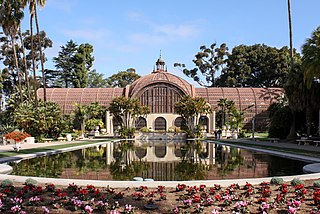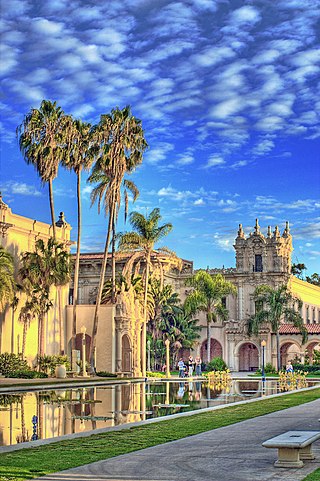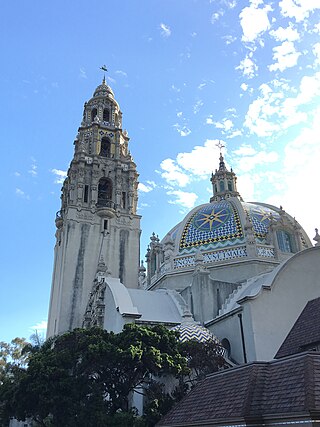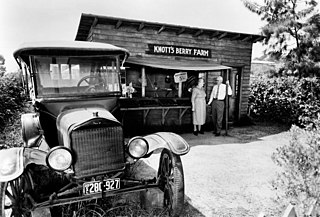
Knott's Berry Farm is a 57-acre (2,500,000 sq ft) amusement park in Buena Park, California, United States, owned and operated by Six Flags. In March 2015, it was ranked as the twelfth-most-visited theme park in North America, while averaging approximately 4 million visitors per year. The park features over 40 rides, including roller coasters, family rides, dark rides, and water rides.

Calico is a ghost town and former mining town in San Bernardino County, California, United States. Located in the Calico Mountains of the Mojave Desert region of Southern California, it was founded in 1881 as a silver mining town, and was later converted into a county park named Calico Ghost Town. Located off Interstate 15, it lies 3 miles (4.8 km) equidistant from Barstow and Yermo. Giant letters spelling CALICO are visible, from the highway, on the Calico Peaks behind it. Walter Knott purchased Calico in the 1950s, and rebuilt all but the five remaining original buildings to look as they did in the 1880s. Calico received California Historical Landmark #782, and in 2005 was proclaimed by then-Governor Arnold Schwarzenegger to be California's Silver Rush Ghost Town.

The Panama–California Exposition was a world exposition held in San Diego, California, between January 1, 1915, and January 1, 1917. The exposition celebrated the opening of the Panama Canal, and was meant to tout San Diego as the first United States port of call for ships traveling north after passing westward through the canal. The fair was held in San Diego's large urban Balboa Park. The park held a second Panama-California exposition in 1935.

The San Diego Air & Space Museum (SDASM) is an aviation and space exploration museum in San Diego, California. It is located in Balboa Park and is housed in the former Ford Building, which is listed on the US National Register of Historic Places. The museum was established by articles of incorporation on October 12, 1961, and opened to the public on February 15, 1963.

Zorro Garden Nudist Colony was an attraction at the 1935–36 California Pacific International Exposition in Balboa Park in San Diego, California. It was located in Zoro Garden, a sunken garden originally created for the 1915-16 Panama–California Exposition. Billed as a nudist colony, it was populated by hired performers rather than actual practicing nudists. The women wore only G-strings; the men wore loincloths or trunks.

Balboa Park Gardens are cultivated areas of Balboa Park in San Diego, California.

The California Pacific International Exposition was an exposition held in San Diego, California, during May 29, 1935–November 11, 1935 and February 12, 1936–September 9, 1936. The exposition was held in Balboa Park, San Diego's large central urban park, which had also been the site of the earlier Panama–California Exposition in 1915.

The Spreckels Organ Pavilion is an outdoor venue that houses the open-air Spreckels Organ in Balboa Park in San Diego, California. With more than 5,000 pipes, the Spreckels Organ is the world's largest pipe organ in a fully outdoor venue. Constructed for the 1915 Panama–California Exposition, it is located at the corner of President's Way and Pan American Road East in the park.

The San Diego Model Railroad Museum is a model railroad museum in San Diego, California. It was founded in 1982. The museum is located on the lower level of Casa de Balboa on the Prado in Balboa Park.

The Ford Building is a Streamline Moderne structure in Balboa Park in San Diego, California, that serves as the home of the San Diego Air & Space Museum. The building was built by the Ford Motor Company for the California Pacific International Exposition, which was held in 1935 and 1936. The Ford Motor Company built a total of five exposition buildings for the world's fairs. This is the last remaining structure.

Oro City is a ghost town in Lake County, Colorado, United States

The Museum of Us is a museum of anthropology located in Balboa Park in San Diego, California. The museum is housed in the historic landmark buildings of the California Quadrangle.

The San Diego Art Institute was a contemporary art museum with a focus on artists from the Southern California and Baja Norte region. It was founded in 1941 as the San Diego Business Men's Art Club. Its name was changed in 1950 to the San Diego Art Institute. In 1953, women were admitted for membership. It officially became a nonprofit in 1963. The San Diego Art Institute in Balboa Park and Lux Art Institute in Encinitas merged in September 2021 to become the Institute of Contemporary Art, San Diego, with each museum continuing to operate at its respective site.

The House of Charm is a historic museum building in Balboa Park in San Diego, California. It was built for the 1915–16 Panama–California Exposition, and like most buildings from the exposition, it features Mission Revival architecture. It acquired its current name during the California Pacific International Exposition. It now houses the Mingei International Museum as well as rehearsal space for the Old Globe Theatre. It is listed on the National Register of Historic Places.

Balboa Park is a 1,200-acre (490 ha) historic urban cultural park in San Diego, California. Placed in reserve in 1835, the park's site is one of the oldest in the United States dedicated to public recreational use. The park hosts various museums, theaters, restaurants, and the San Diego Zoo. It is managed and maintained by the Parks and Recreation Department of the City of San Diego.

The French Cottage or House of France is a founding member of the House of Pacific Relations (HPR) in Balboa Park, San Diego, United States. The House of France is the only French-American non-profit association in the City of San Diego.

The Knott's Berry Farm amusement park in Orange County, California, originated from a berry farm owned by Walter Knott (1889–1981). In the 1920s, Knott and his wife, Cordelia, sold berries, berry preserves and pies from a roadside stand beside State Route 39, near the small town of Buena Park.
Richard Smith Requa was an American architect, largely known for his work in San Diego, California. Requa was the Master Architect for the California Pacific International Exposition held in Balboa Park in 1935–36. He improved and extended many of the already existing buildings from the ealier Panama–California Exposition, as well as creating new facilities including the Old Globe Theatre.

The California Quadrangle, California Building, and California Tower are historic structures located in Balboa Park in San Diego, California. They were built for the 1915–16 Panama–California Exposition and served as the grand entry to the event. The buildings and courtyard were designed by architect Bertram Goodhue. They were added to the National Register of Historic Places on May 17, 1974. They now house the Museum of Us.

The House of Hospitality is a building in Balboa Park in San Diego, California. It was originally built for the Panama–California Exposition (1915) as the Foreign Arts Building.


















